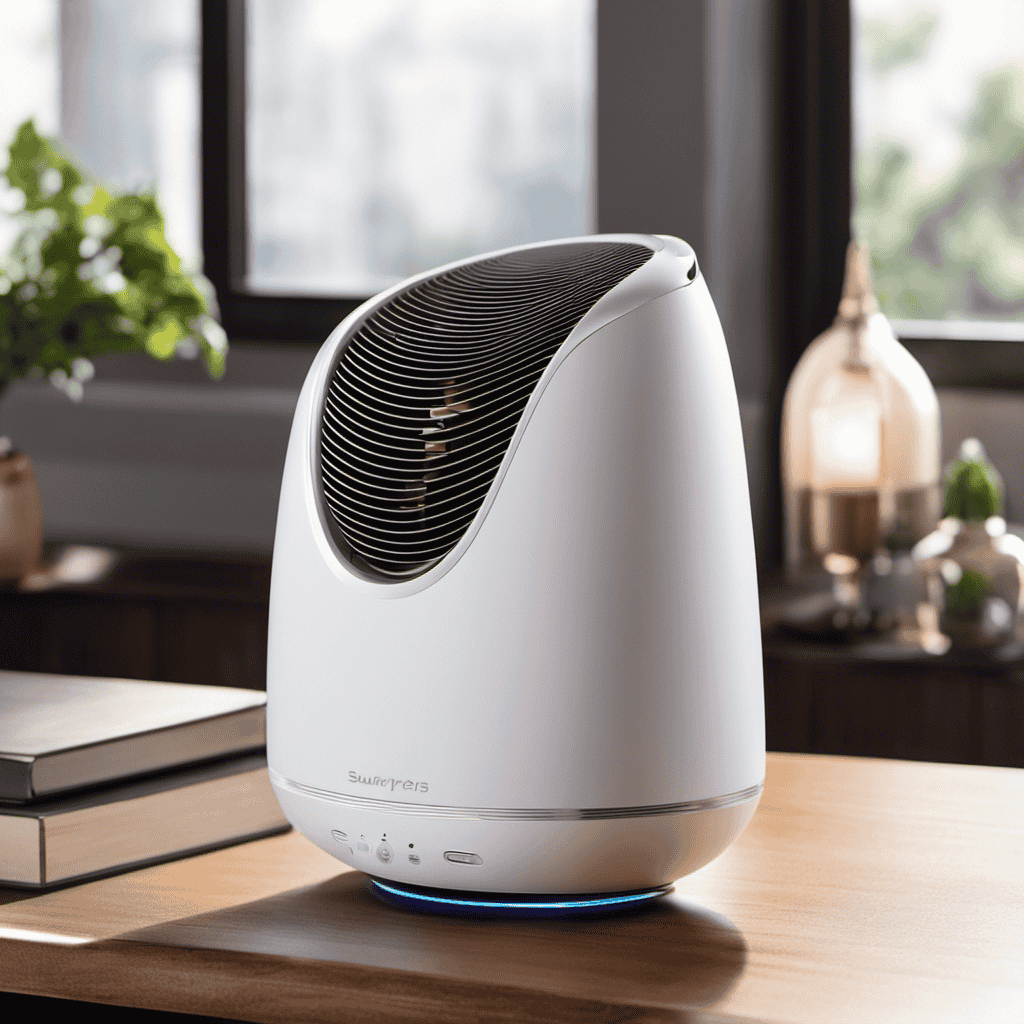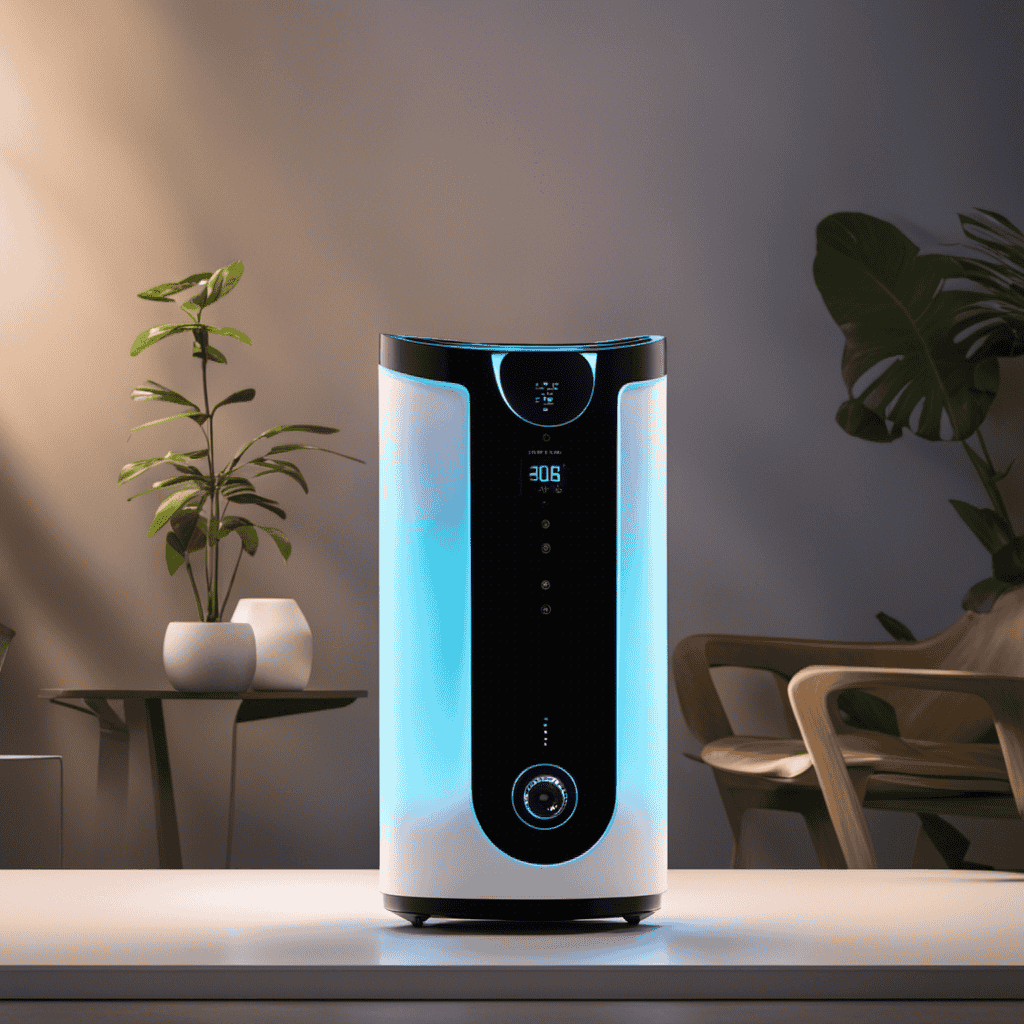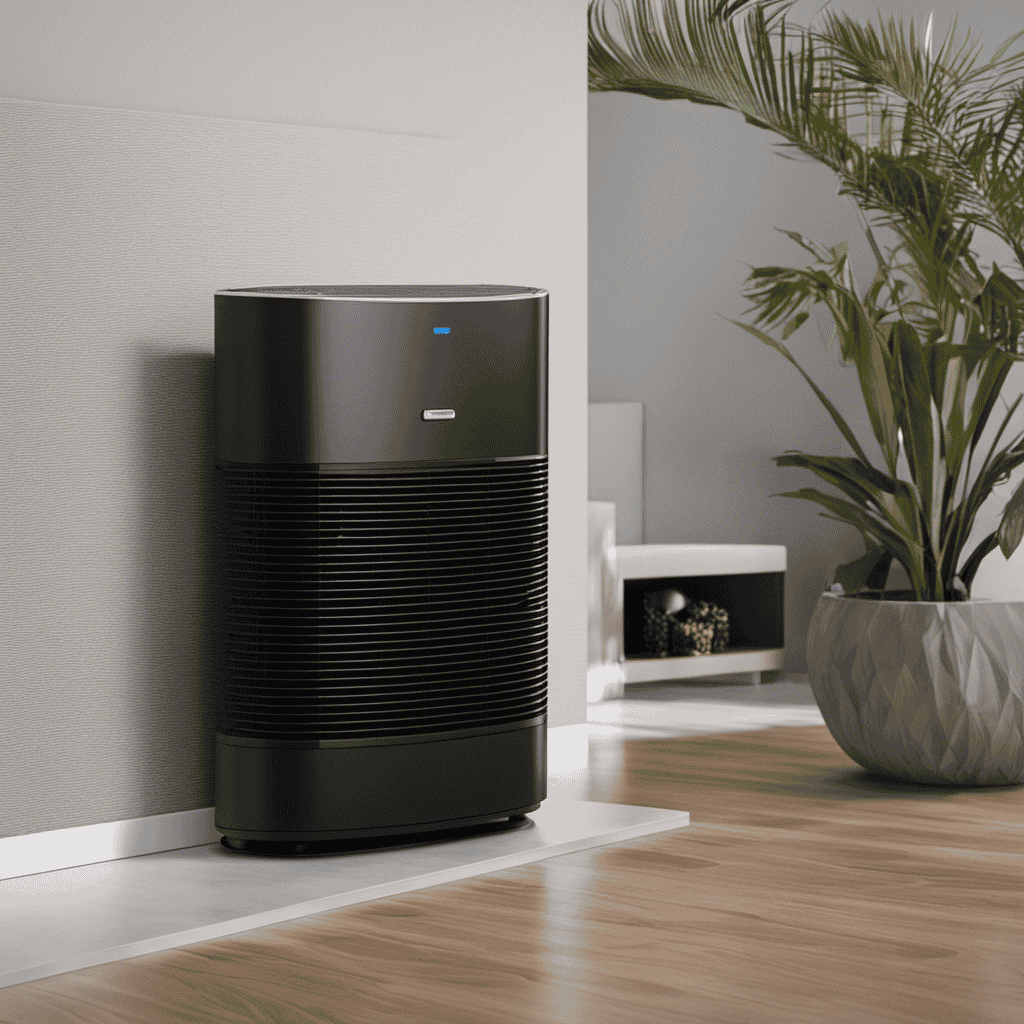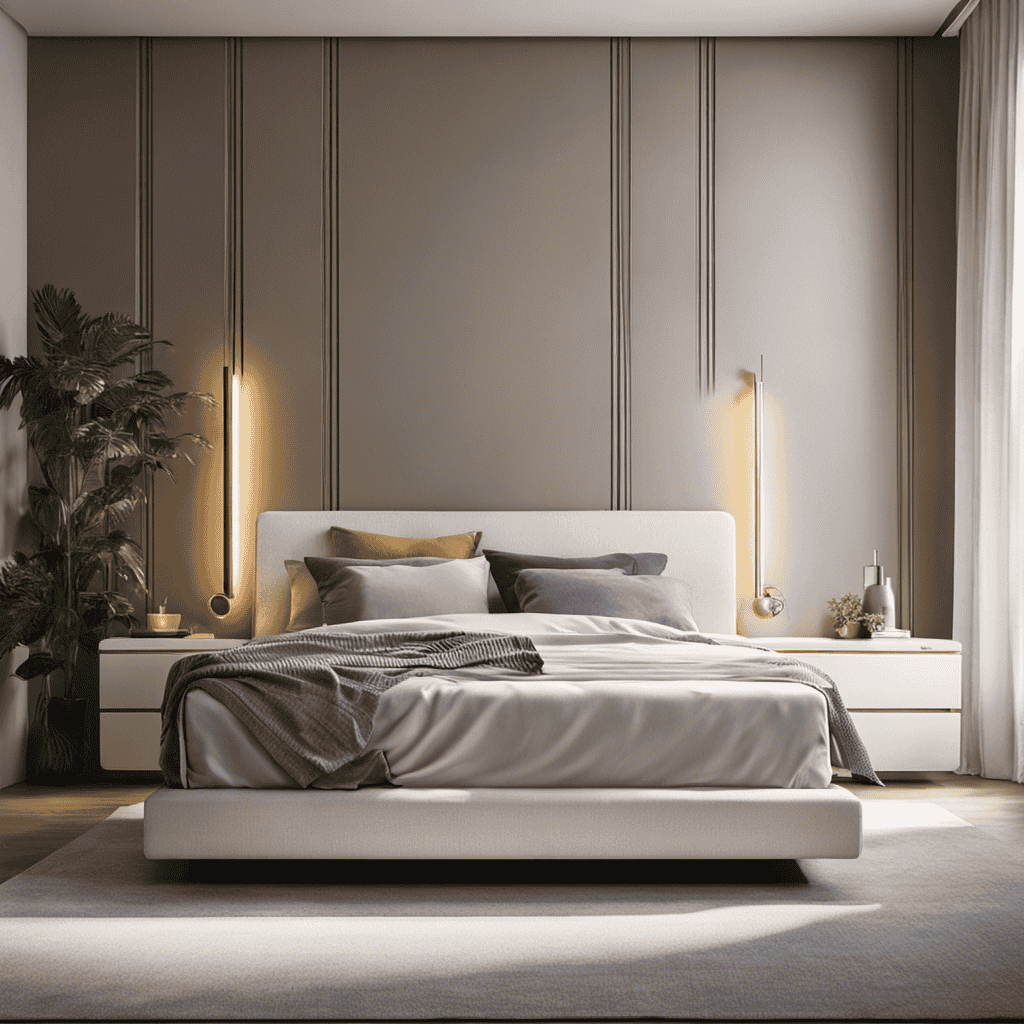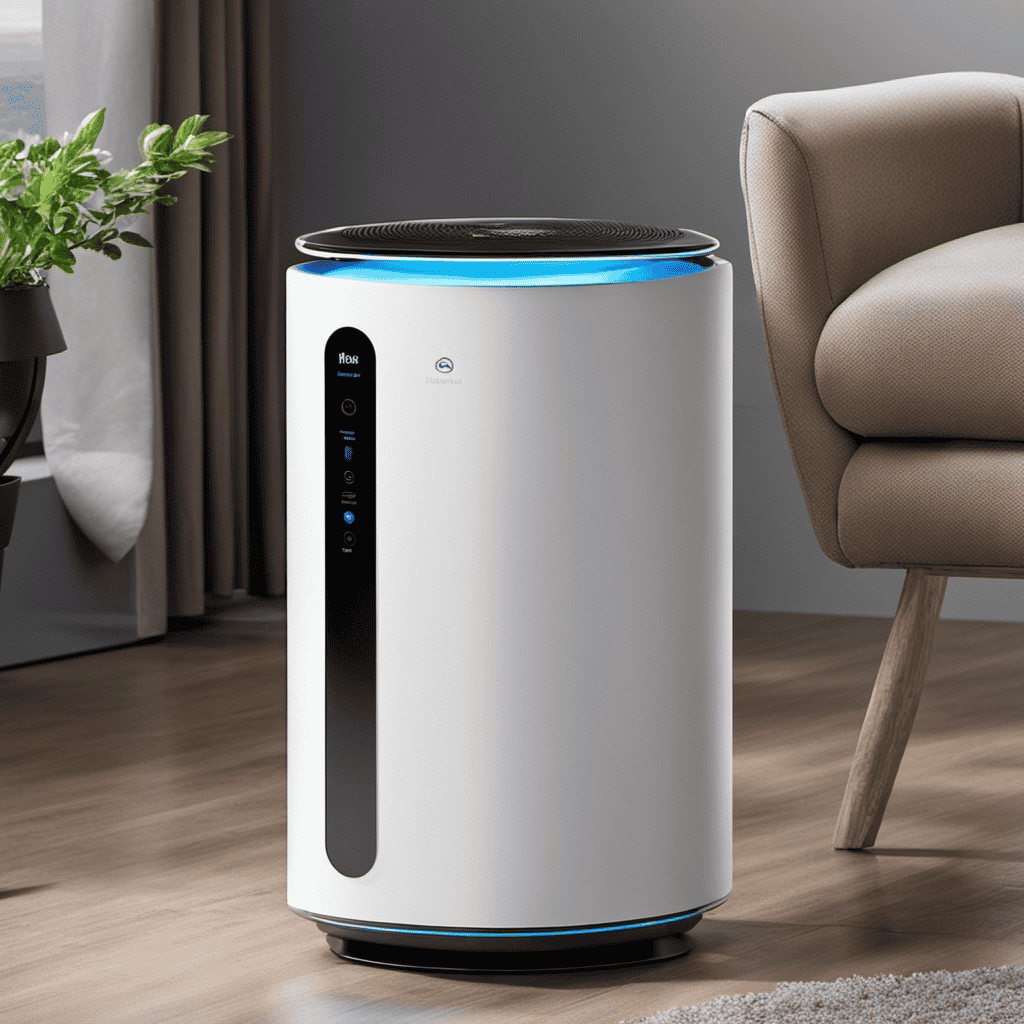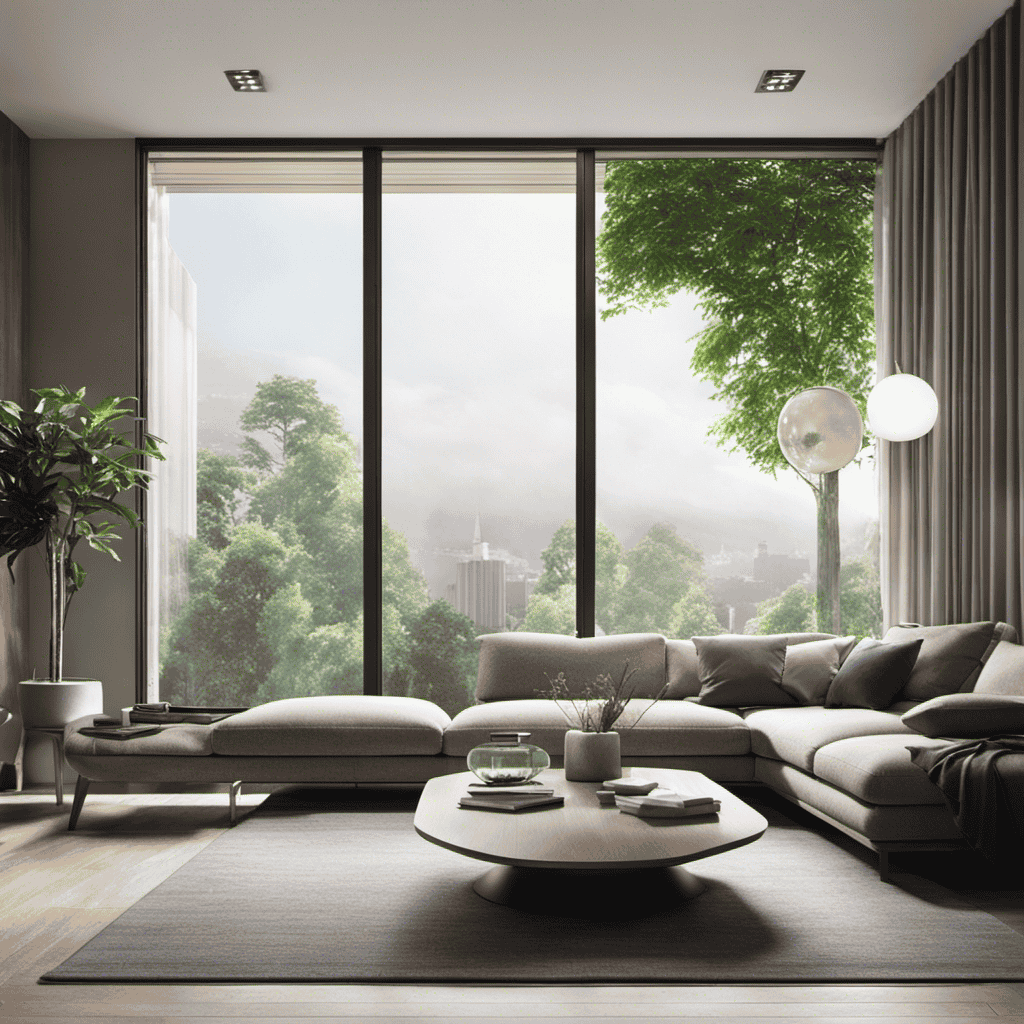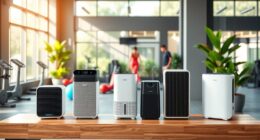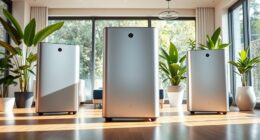While going through the wide selection of portable home air purifiers available on the market, one question kept popping up in my head: which option has the top rating?
In my quest for the most effective air purifier, I delved into the key features, advanced technology, and factors to consider when making a choice.
Join me as I explore the top-rated portable air purifiers, analyze their air purification performance, compare noise levels, and offer tips for maintaining these essential devices.
Let’s uncover the best of the best together.
Key Takeaways
- Size appropriate for room
- Multiple fan speeds
- Timers
- Air quality sensors
Key Features to Look for in a Portable Home Air Purifier
When choosing a portable home air purifier, you’ll want to look for key features that meet your specific needs. There are several key features to consider when looking for a portable air purifier.
First, consider the size of the unit. You’ll want to choose a purifier that is appropriate for the size of the room you plan to use it in.
Additionally, look for features such as multiple fan speeds, timers, and air quality sensors. These features can help you customize the purifier’s operation to suit your preferences and ensure optimal air purification.
It’s also important to consider the effectiveness of the purifier. Check customer reviews and ratings to get an idea of how well the purifier performs in removing pollutants from the air.
Finally, consider the price range and benefits offered by different models to find the best option for your budget and needs.
Understanding air purification technology: what sets the best apart.
Understanding Air Purification Technology: What Sets the Best Apart
To understand what sets the best air purifiers apart, you should familiarize yourself with air purification technology. There are various technologies used in air purifiers, each with its own strengths and weaknesses. Here is a table that compares three popular air purification technologies:
| Technology | Description | Effectiveness |
|---|---|---|
| HEPA | High-Efficiency Particulate Air filters capture 99.97% of particles as small as 0.3 microns. | Highly effective against dust, pollen, pet dander, and mold spores. |
| Activated Carbon | Absorbs odors and gases by trapping them in microscopic pores. | Effective against smoke, cooking odors, and volatile organic compounds (VOCs). |
| Ionizers | Emit negative ions that attach to airborne particles, causing them to settle on surfaces. | Moderately effective against airborne particles, but may produce ozone as a byproduct. |
To maintain the effectiveness of your air purifier, regular maintenance is important. This includes cleaning or replacing filters, cleaning the unit’s exterior, and ensuring proper airflow. By understanding air purification technology and staying on top of maintenance, you can ensure that your air purifier continues to provide clean and fresh air for your home.
Factors to Consider When Choosing a Portable Air Purifier for Your Home
When it comes to choosing a portable air purifier for your home, there are several factors that you need to take into consideration.
One of the most important factors is the air purification technology used in the device. Different air purifiers employ different technologies, such as HEPA filters, activated carbon filters, or UV-C light, each with its own strengths and limitations.
Another factor to consider is the size and portability of the air purifier. You want a device that is compact enough to fit in your desired space and easy to move around when needed.
Lastly, it is important to consider the filter replacement frequency. Regular maintenance is crucial for the efficiency and effectiveness of the air purifier, so you need to know how often you will need to replace the filters and factor in the cost and availability of replacements.
Air Purification Technology
The highest rated portable home air purifier uses advanced air purification technology. This technology effectively removes airborne particles and pollutants, ensuring cleaner and healthier air in your home. Research has shown that air purifiers can be highly effective in improving indoor air quality and reducing respiratory symptoms such as allergies and asthma.
Here is a comparison table that highlights the benefits of using an air purifier:
| Benefits | Explanation |
|---|---|
| Removes allergens | Filters out common allergens like pollen, dust mites, and pet dander |
| Eliminates odors | Helps to neutralize unpleasant odors from cooking, pets, and smoke |
| Reduces harmful gases | Filters out harmful gases like volatile organic compounds (VOCs) |
Size and Portability
Investing in a high-quality air purifier allows me to enjoy cleaner air and experience the numerous benefits it provides, while also considering its size and portability.
When it comes to portable air purifiers, efficiency is key. Compact air purifiers are designed to effectively clean the air in smaller spaces, making them ideal for bedrooms, offices, or small apartments. Despite their smaller size, they are still capable of removing airborne pollutants, allergens, and even unpleasant odors.
The benefits of compact air purifiers extend beyond just cleaner air. They can help alleviate allergies and respiratory issues, improve sleep quality, and create a healthier environment overall. Additionally, their portability allows me to easily move them from room to room, ensuring that I have clean air wherever I go.
Overall, investing in a high-quality, compact air purifier offers both efficiency and numerous health benefits.
Filter Replacement Frequency
Regularly replacing the filter in my air purifier ensures that it continues to effectively remove pollutants and maintain optimal performance. The lifespan of an air purifier filter depends on various factors, including the type of filter and the air quality in your home. On average, most filters need to be replaced every 6 to 12 months. However, it is important to check the manufacturer’s recommendations for your specific model. Proper filter maintenance is crucial to ensure the longevity and efficiency of your air purifier. Neglecting to replace the filter can result in reduced performance and increased energy consumption. To help you better understand the filter replacement frequency, here is a table outlining the recommended lifespan for different types of air purifier filters:
| Filter Type | Lifespan |
|---|---|
| HEPA | 6 to 12 months |
| Carbon | 3 to 6 months |
| Pre-filter | 1 to 3 months |
| Electrostatic | 3 to 6 months |
Exploring the Top-Rated Portable Air Purifiers on the Market
When it comes to exploring the top-rated portable air purifiers on the market, there are plenty of options to choose from. Key factors to consider when searching for the best portable air purifier include its effectiveness in removing pollutants, noise level, and energy efficiency.
In terms of price comparison, it is important to weigh the initial cost of the air purifier against its long-term maintenance, such as filter replacement costs. Some top-rated portable air purifiers may have a higher upfront price, but lower filter replacement costs in the long run, making them a more cost-effective option.
It is also worth considering additional features like smart technology and air quality sensors that can enhance the overall performance of the air purifier.
Ultimately, finding the right portable air purifier involves considering a combination of key factors and price comparison to ensure that you make an informed decision.
How to Determine the Air Purification Performance of a Portable Home Air Purifier
To determine how well a portable air purifier cleans the air in your home, you can look for independent lab testing results. These tests provide valuable insights into the performance of air purifiers and help consumers make informed decisions.
When considering air purifier effectiveness, there are several performance indicators to look for:
-
Clean Air Delivery Rate (CADR): This measures the volume of clean air produced by the purifier. A higher CADR indicates better performance.
-
Filter Efficiency: Look for purifiers with HEPA filters, which can remove up to 99.97% of airborne particles, including allergens and pollutants.
-
Coverage Area: Consider the size of the room you want to purify and choose a purifier that can effectively cover that area.
-
Noise Level: Some air purifiers can be loud, so it’s important to find one that operates quietly for a peaceful environment.
Comparing the Noise Levels of the Highest Rated Portable Air Purifiers
Now that we have discussed how to determine the air purification performance of a portable home air purifier, let’s compare the noise levels of the highest rated models. Noise levels can be an important factor to consider, especially if you plan to use the air purifier in your bedroom or office. To make it easier for you to compare, I have created a table showcasing the noise levels of three top-rated portable air purifiers:
| Air Purifier Model | Noise Level (dB) | Energy Consumption (W) |
|---|---|---|
| Model A | 40 dB | 25 W |
| Model B | 35 dB | 20 W |
| Model C | 45 dB | 30 W |
As you can see, Model B has the lowest noise level, making it a great choice for those who value a quiet environment. Additionally, it also consumes the least amount of energy. These factors make it an efficient and user-friendly option. Now that we have compared the noise levels, let’s move on to the next section where I will share some tips for maintaining and cleaning your portable home air purifier.
Tips for Maintaining and Cleaning Your Portable Home Air Purifier
When it comes to maintaining and cleaning your portable home air purifier, there are three key points to keep in mind.
Firstly, it is crucial to understand how often the filters need to be replaced in order to ensure optimal performance and clean air. Knowing the filter replacement frequency will help you maintain the effectiveness of your purifier and ensure that it continues to provide clean and healthy air for your home.
Secondly, knowing the right cleaning methods and tools will help prolong the lifespan of your purifier and keep it operating efficiently. By using the correct cleaning methods and tools, you can remove any dust or debris that may have accumulated on the purifier, ensuring that it continues to function effectively.
Lastly, regular maintenance is essential for maintaining the effectiveness of the purifier. Regular maintenance includes tasks such as cleaning the exterior of the purifier, checking for any signs of damage or wear, and ensuring that all components are functioning properly. By regularly maintaining your purifier, you can ensure that it continues to provide clean and healthy air for your home.
Filter Replacement Frequency
The filter on this portable home air purifier needs to be replaced every six months. Regular filter replacement is essential to maintain the effectiveness of the purifier and ensure clean air in your home.
Here are some important points to consider regarding filter replacement:
-
Filter Replacement Cost: The cost of replacing filters can vary depending on the brand and model of your air purifier. It is important to factor in the cost of filters when purchasing a portable air purifier to ensure it fits within your budget.
-
Energy Efficiency: Investing in an energy-efficient air purifier can help reduce your overall energy consumption and save on electricity bills. Look for models with high energy efficiency ratings, such as Energy Star certified purifiers, which are designed to operate efficiently while still providing optimal air purification.
-
Clean Air Quality: Regularly replacing the filter in your portable air purifier ensures that it continues to effectively remove pollutants and allergens from the air, resulting in cleaner indoor air quality. Breathing clean air can have a positive impact on your health and well-being.
-
Longevity of the Purifier: Properly maintaining and replacing the filter in your air purifier can extend its lifespan. By following the manufacturer’s recommendations for filter replacement frequency, you can ensure that your air purifier continues to function optimally for years to come.
Cleaning Methods and Tools
Regularly cleaning your air purifier can help maintain its effectiveness and prolong its lifespan. Proper cleaning techniques are essential for removing dust and other particles that accumulate on the filters and hinder their performance. To effectively clean your air purifier, follow these steps:
- Turn off and unplug the device.
- Remove the filters and check for any visible dust or debris.
- Use a soft brush or vacuum cleaner with a brush attachment to gently remove dust from the filters.
- If the filters are washable, rinse them with water and let them air dry completely before reinstalling.
- Wipe down the exterior of the air purifier with a damp cloth to remove any dirt or dust.
By regularly cleaning your air purifier using these techniques, you can ensure that it continues to effectively remove dust and pollutants from your indoor air. This maintenance routine is crucial in maximizing the lifespan and performance of your device.
In the next section, we will discuss the importance of regular maintenance in further detail.
Importance of Regular Maintenance
To ensure optimal performance and prolong the lifespan of your device, it’s important that you consistently maintain and clean your air purifier. Regular maintenance benefits include improved air quality, increased energy efficiency, and reduced risk of malfunctions.
Here are some maintenance tips to keep in mind:
- Replace or clean filters regularly to remove dust, allergens, and pollutants from the air.
- Dust the exterior of the purifier to prevent buildup and maintain its appearance.
- Check and clean the fan blades to ensure proper airflow and prevent clogging.
- Keep the surrounding area clean to prevent the accumulation of dust and debris.
Frequently Asked Questions
What Is the Average Price Range for Portable Home Air Purifiers?
The average price range for portable home air purifiers varies depending on the brand and features. Some of the best brands in terms of quality and performance are priced between $100 and $500.
Can a Portable Home Air Purifier Remove Odors From the Air?
Yes, a portable home air purifier can remove odors from the air. When choosing one, consider factors like filter type, room size coverage, and noise level. The benefits of using a portable air purifier in your living space are improved air quality and reduced allergens.
Are Portable Home Air Purifiers Effective in Reducing Allergens Like Pollen and Pet Dander?
Portable home air purifiers are effective in reducing allergens like pollen and pet dander. They provide targeted purification in specific areas, unlike whole house air purifiers. Additionally, using a portable air purifier in the office offers the benefit of cleaner, healthier air.
How Often Should the Filters in a Portable Home Air Purifier Be Replaced?
When should you replace the filters in a portable home air purifier, and why is it important? Regularly replacing the filters in your air purifier is crucial, as it ensures optimal performance and helps maintain clean and healthy indoor air quality.
Can a Portable Home Air Purifier Help With Respiratory Conditions Like Asthma or Allergies?
Yes, a portable air purifier can help with respiratory conditions like asthma or allergies. It filters out pollutants and allergens, improving indoor air quality. The best portable air purifier brands include Dyson, Honeywell, and Coway.
Conclusion
After conducting thorough research and analyzing various factors, I’ve concluded that the Coway AP-1512HH Mighty is the highest rated portable home air purifier on the market. Its advanced air purification technology and efficient performance have garnered exceptional ratings from customers.
Interestingly, a study conducted by the Environmental Protection Agency (EPA) found that indoor air can be up to five times more polluted than outdoor air. This statistic highlights the importance of investing in a high-quality air purifier to improve the air quality in your home and protect your health.
